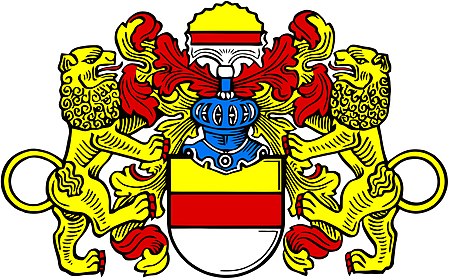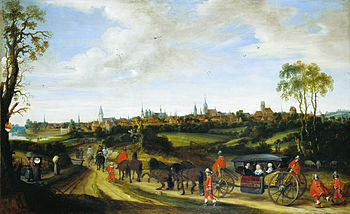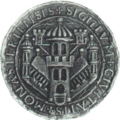Munster coat of arms
|
Münster (Westphalia) State of North Rhine-Westphalia |
|
|---|---|

|
|
| Blazon | |
Unknown 1 . Description of coat of arms according to the template of the city of Münster:
|
|
| Basic data | |
| Introduction: | |
| Legal basis: | Seal tour: around 1368 |
| Supporting documents: | |
| Changes: | |
| swell | |
|
1 There is no blazon in the main statutes (PDF, 68556 bytes), nor is it recorded in the documents of the city archive. |
|
In addition to its coat of arms , the city of Münster in Westphalia also has a seal and flag . The coat of arms is one of the oldest in use in Germany and therefore contains some special features.
coat of arms
The coat of arms of the city of Münster is striped lengthways in a ratio of 1: 1: 1 gold-red-silver. It is a modification of the coat of arms of the diocese (gold-red-gold). Other sources speak of a combination with the coat of arms of the Hanseatic League (red and silver). Apparently, however, it was never set, approved, or awarded.
The prince-bishop's coat of arms in gold-red-gold, whose first bearers were Konrad von Berg in 1309 and Ludwig von Hessen in 1310, is proven around 1300 as the coat of arms of the Münster monastery . It is still run by the city of Werne and can be found in the coats of arms of the Borken , Coesfeld and Steinfurt districts . The Meppen coat of arms is also derived from Münster.
The oldest known depiction of the city's coat of arms, on the other hand, dates from 1368, which can be seen on a certificate from the Antonius Hospital . The seal stamp with which this document was created is said to have been around 50 years older and was created at the time the hospital was founded, probably before 1320. The first color image of the city's coat of arms has come down to us from the 15th century. Occasionally a version can be seen in which the golden field is dotted and the red bar is hatched vertically. This was a system from before color printing was possible. The coat of arms of the city of Münster is special in that, unlike most other coats of arms, it is not derived from the city seal.
The large coat of arms, officially adopted in 1928, shows a shield divided by gold, red and silver with a blue-silver spangenhelm with a necklace and a medallion in the middle, both silver, helmet bulge blue-silver, crest a gold-red-silver divided umbrella board with 17 points, helmet covers red-gold and shield holder with two standing, golden, red-tongued and armored lions facing the shield. The lions are dated to the middle of the 16th century.
Until the 16th century, griffins were sometimes used instead of lions . In other depictions, only a resisting lion held the shield. Both types can be seen on the facades of the houses on Prinzipalmarkt . The version with a griffin holding the coat of arms as a shield can be seen on the historic town hall . Also in the painting arrival of the Dutch ambassador Adriaan Pauw at Münster by Gerard ter Borch is in a simplified form as a town sign attached to a tree.
seal
The seal of the city of Münster in use shows the Münster bar coat of arms with the alternative tinging in the form of points for gold and vertical stripes for red. It is circumscribed in the lower semicircle with STADT MÜNSTER . It differs greatly from the first seal of the city of Münster, which can be verified as an imprint on a document around the year 1231.
From the 13th to the 16th century, the historic large city seals of Münster showed a city gate with a defensive tower , behind which a walled city. The inscription read SIGILLVM CIVITATIS MONASTERIENSIS ("Seal of the Münster citizenship").
The hidden back of the wax prints, the so-called Small City Seal or Secretus, showed a half-length portrait of St. Paul with a sword and a halo and was first handed down to 1277. It was circumscribed with SECRETVM CIVITATIS MONASTERIENSIS ( Secretary of the City of Münster). However, other forms have also been passed down in which the description differs. So there was a version of the secretions seal that with SANCTUS PAVLVS APOSTOLVS was circumscribed.
1560: Seal of Bernhard von Raesfeld , Prince-Bishop of Münster
The two town seals were destroyed by the Anabaptists in 1534 . After the defeat of the Anabaptists and the takeover of the city by Prince-Bishop Franz von Waldeck , a new seal was used from 1536, which was very similar to the old one. It still showed the cityscape, but was supplemented by the prince-bishop's bar coat of arms in the city gate. It became less important from the 1560s when documents with imprinted lacquer seals were used instead of wax seals attached. It was sold in 1776 and is believed to be melted down.
The small seal, which was newly made after the defeat of the Anabaptists, also remained identical in its basic representation, only adapted to the style of the 16th century, but also provided with the prince-bishop's bar coat of arms. From the 1560s it slowly took over the function of the big seal, and from the beginning of the 17th century it was only used as a city seal. It was in use until the principality of Münster was dissolved in 1802 and is kept in the Münster City Museum .
The seal of Bernhard von Raesfeld (* 1508, † 1574), Prince-Bishop of Münster 1557–1566, combines the coat of arms of the bishopric of Münster (red bar in gold) with the family coat of arms of those von Raesfeld (blue bar in gold).
flag
In addition to the seal and the coat of arms, the city of Münster also wields a flag. Obviously there was no official approval or award, so that the only source for this is a template from the city. As with the coat of arms, there are two different flags, each with stripes of the same width. The regular flag is based on the colors used in the coat of arms and consists of three vertical stripes with the colors yellow, red and white. There is also a splendid version, striped lengthways in yellow, red, white, red and yellow with the city's large coat of arms in the middle. The two yellow and white stripes are also provided with red bibs at the lower end.
literature
- Ernst Hövel: Sources and research on the history of the city of Münster. Volume 4, Münster 1931, pp. 135-221.
- Peter Veddeler: The Munster beam coat of arms. Creation and development of a regional coat of arms. (Westphalia. Hefte für Geschichte, Kunst und Volkskunde, 69th volume, 1991), Aschendorffsche Verlagsbuchhandlung, Münster 1993, ISSN 0043-4337
- Ralf Klötzer: The coat of arms of the city of Münster. Information brochure from the Press and Information Office of the City of Münster, Münster 2007.
Web links
- International Civic Heraldry - www.ngw.nl
Individual evidence
- ↑ Veddeler, Das Münsterische Barkenwappen , p. 115 f.
- ↑ Veddeler, Wappen, Siegel, Flaggen , Münster 2003 (publications of the historical commission for Westphalia V), p. 183.
- ↑ The main statute ( memento of April 9, 2008 in the Internet Archive ) of the city of Münster does not regulate the use of the coat of arms
- ↑ Tumbülle, Westf. Siegel II , 2, plate 84, fig. 7








